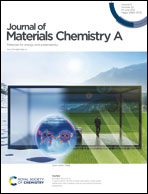Energy scavenging luminescent piezo-fabrics: small silicon dots enable big electrical outputs†
Abstract
Modern technologies are built on earth-abundant silicon. In this regard, the emerging autonomous micro/nanosystems urgently need to be compatible with the existing silicon-based infrastructure in terms of materials design and device assembly. Here, we for the first time demonstrate the incredible potential of silicon-based quantum dots (SiDs) for flexible and self-powered optoelectronics. The inclusion of an extremely small amount of luminescent SiDs enables a significant enhancement of piezoresponse of electrospun SiDs/polymer fabrics. Meanwhile, the hybrid fabrics retain the photoluminescent response of SiDs. Strikingly, the voltage output and current output of the hybrid fabrics reach 446 V cm−3 and 8.1 µA cm−3, respectively, which are almost 11 times and 19 times higher than those of state-of-the-art pristine fabrics, respectively. Moreover, the luminous fabric-based piezoelectric nanogenerator exhibits a highly durable and highly stable piezoresponse in more than 10 000 uninterrupted load cycles. As a proof of concept, in the scenario of a tennis match, the luminescent prototype device is further employed as a self-powered tactile sensor for real-time sports monitoring and athlete physiology monitoring. It shows ultrahigh mechanical sensitivity, flexibility, and reliability in sensing a broad range of strains and pressures. This study provides a new insight for accelerating the development of current and future self-powered micro/nanosystems.



 Please wait while we load your content...
Please wait while we load your content...